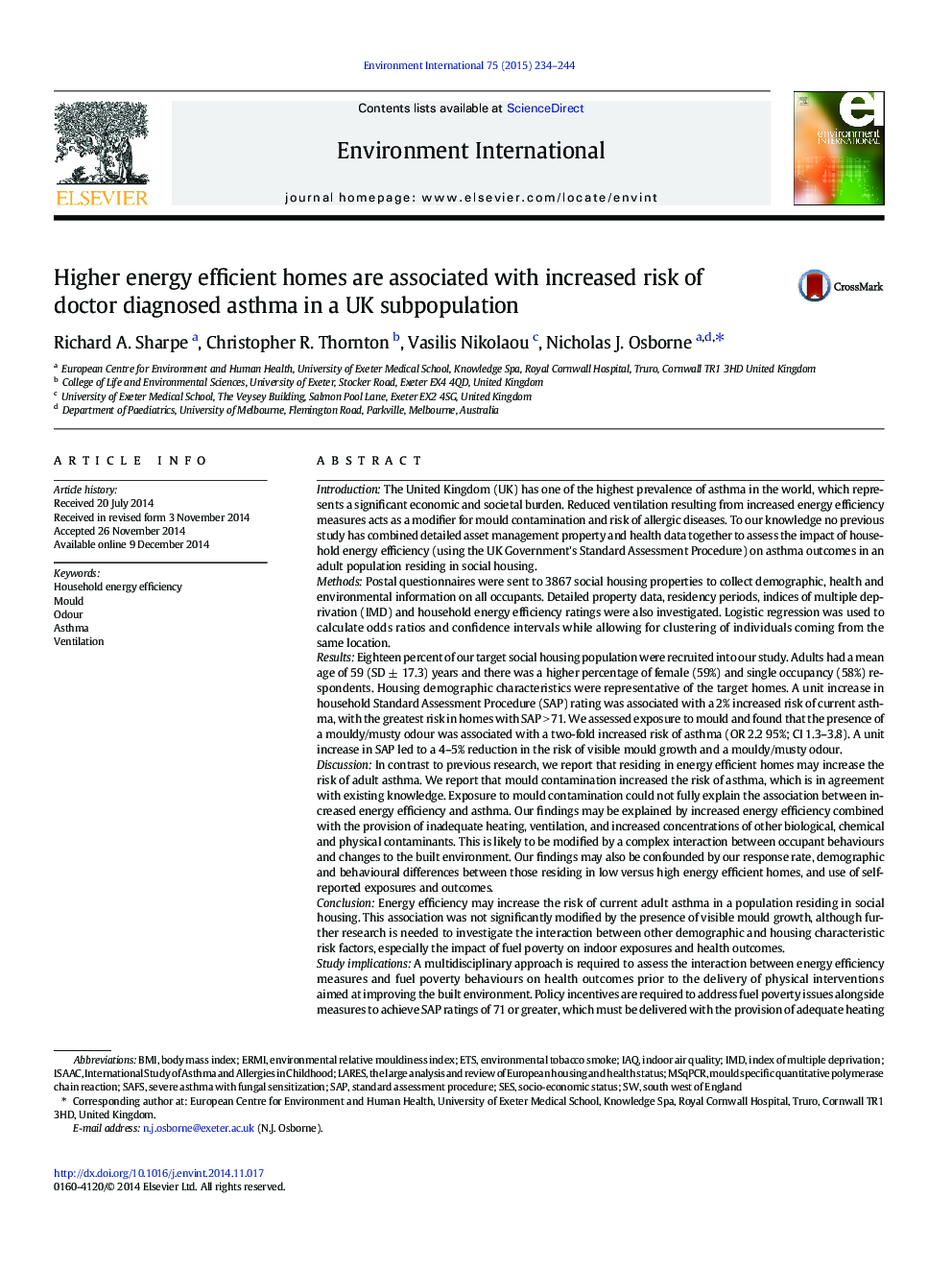| کد مقاله | کد نشریه | سال انتشار | مقاله انگلیسی | نسخه تمام متن |
|---|---|---|---|---|
| 4422712 | 1619053 | 2015 | 11 صفحه PDF | دانلود رایگان |
• Increased household energy efficiency may increase risk of current asthma.
• A mouldy/musty odour was associated with a two-fold increased risk of asthma.
• Energy efficiency with SAP (Standard Assessment Procedure) > 71 is required to minimise risk of damp and mould.
• Housing upgrades without changes in occupant behaviours may lead to negative health outcomes.
IntroductionThe United Kingdom (UK) has one of the highest prevalence of asthma in the world, which represents a significant economic and societal burden. Reduced ventilation resulting from increased energy efficiency measures acts as a modifier for mould contamination and risk of allergic diseases. To our knowledge no previous study has combined detailed asset management property and health data together to assess the impact of household energy efficiency (using the UK Government's Standard Assessment Procedure) on asthma outcomes in an adult population residing in social housing.MethodsPostal questionnaires were sent to 3867 social housing properties to collect demographic, health and environmental information on all occupants. Detailed property data, residency periods, indices of multiple deprivation (IMD) and household energy efficiency ratings were also investigated. Logistic regression was used to calculate odds ratios and confidence intervals while allowing for clustering of individuals coming from the same location.ResultsEighteen percent of our target social housing population were recruited into our study. Adults had a mean age of 59 (SD ± 17.3) years and there was a higher percentage of female (59%) and single occupancy (58%) respondents. Housing demographic characteristics were representative of the target homes. A unit increase in household Standard Assessment Procedure (SAP) rating was associated with a 2% increased risk of current asthma, with the greatest risk in homes with SAP > 71. We assessed exposure to mould and found that the presence of a mouldy/musty odour was associated with a two-fold increased risk of asthma (OR 2.2 95%; CI 1.3–3.8). A unit increase in SAP led to a 4–5% reduction in the risk of visible mould growth and a mouldy/musty odour.DiscussionIn contrast to previous research, we report that residing in energy efficient homes may increase the risk of adult asthma. We report that mould contamination increased the risk of asthma, which is in agreement with existing knowledge. Exposure to mould contamination could not fully explain the association between increased energy efficiency and asthma. Our findings may be explained by increased energy efficiency combined with the provision of inadequate heating, ventilation, and increased concentrations of other biological, chemical and physical contaminants. This is likely to be modified by a complex interaction between occupant behaviours and changes to the built environment. Our findings may also be confounded by our response rate, demographic and behavioural differences between those residing in low versus high energy efficient homes, and use of self-reported exposures and outcomes.ConclusionEnergy efficiency may increase the risk of current adult asthma in a population residing in social housing. This association was not significantly modified by the presence of visible mould growth, although further research is needed to investigate the interaction between other demographic and housing characteristic risk factors, especially the impact of fuel poverty on indoor exposures and health outcomes.Study implicationsA multidisciplinary approach is required to assess the interaction between energy efficiency measures and fuel poverty behaviours on health outcomes prior to the delivery of physical interventions aimed at improving the built environment. Policy incentives are required to address fuel poverty issues alongside measures to achieve SAP ratings of 71 or greater, which must be delivered with the provision of adequate heating and ventilation strategies to minimise indoor dampness. Changes in the built environment without changes in behaviour of domicile residents may lead to negative health outcomes.
Journal: Environment International - Volume 75, February 2015, Pages 234–244
